Acacia gordonii



Woody
Stems and branches with a woody texture commonly associated with shrubs or perennials.
Spreading-ascending
When a plant has stems that gradually grow upwards.This small shrub has slender white pubescent light brown stems that form a straggly open habit. It has small dark green linear leaves and the fragrant ball-shaped bright yellow flowers appear towards the end of the branches in early spring.
Acacia gordonii (Tindale) Pedley, is naturally found in a restricted region on the eastern lower slopes of the Blue Mountains near Sydney, New South Wales Australia and is regarded as endangered due to habitat loss. It grows in dry sclerophyll forest and heath on the sandstone hillsides and in the plains up to an altitude of 400 m (1,312 ft). It prefers a well drained, poor to fertile sandy-stony soil to light clay that is tending acidic with a pH range from 6.0 to 7.0. It grows in a open to protected sunny position and is drought and frost tolerant with a preferred minimum winter temperature of -2ºC (28ºF).
Gordon's Wattle is a small shrub that is grown for its bright yellow flowers and low bushy habit. It is planted in small or native gardens as a specimen or used in woodland settings. It is suitable for coastal regions and the adjoining tablelands and is used as an understory plant. It establishes in 1 to 2 years but may be short lived. This small shrub is planted in sunny rockeries or can be grown in pots, tubs and used in roof gardens. It has a low water requirement once established (Scale: 1-drop from 3), and has an annual rainfall between 900-1000 mm. It prefers to have reliable moist sandy soil and will tolerate dry periods.
ID 4
UK hardiness zone H2
Climate zones 15 - 24, H1
USDA Zone 9-10
Note:
This plant is not commonly cultivated and may be difficult to obtain requiring a specialist nursery.
Acacia (a-KAY-see-a) gordonii (gor-do-ne-i)
Etymology
Genus: Greek - Acacia – from ‘akis’ - (a sharp point) referring to the thorns or the Egyptian thorn ‘akakia’ a species of Acacia that produces gum Arabic
Species: – gordonii – named after Robert Jacob Gordon (1743-1795) who was a Dutch explorer

Australia, (Blue Mountains)
Fabaceae (fab-AY-see-ee)
subfamily Mimosoideae
Wattles
This family consists of trees or shrubs primarily consisting of the Acacia genus in Australia.
Distribution
These plants are found in tropics to temperate climate zones with 3,000 species worldwide with 700 species in Australia.
Diagnostic features
The leaves may be compound (bipinnate) or reduced to phyllodes, normally having stipules and commonly arranged alternately.
The inflorescence is a raceme, spike or in heads that are terminal or axillary.
The tiny flower is normally bisexual but sometimes unisexual and is composed of 4 to 5 petals that may be imbricate. The conspicuous stamens may number the same as the sepals or be more numerous and are unfused or fused and may be attached to the base of the corolla tube.
The superior ovary is sessile or stalked commonly with numerous ovules and the style is normally filiform.
The fruit is a legume that is normally dry and contains many seeds.
The seeds have a tough coat and are round or kidney shaped. These seeds commonly have a bright coloured aril and have a long viability period. They require scarification before germination.
Note:
Many of these plants (mainly the 1,450 Acacia spp) have showy flowers and make good garden specimens; quick growing but short lived. These plants also produce valuable timber or the bark is used for dyes.
This plant tolerates between USDA zones 9a to 10a and grows to 1.5 m (5 ft)
Fahrenheit 20º to 30º F
These temperatures represent the lowest average.
Celsius -6.6º to -1.1º C

Attention
This plant was last revised on the 4/07/2019
The information displayed on this plant is based on research conducted in our horticultural library and from reliable online resources. We also make observations of the plant that we photograph, and all care is taken to ensure the details are correct.
All photographs and data are covered by copyright. Apart from any fair dealing for the purpose of private study, research, reference or review, as permitted under the Copyright Act, no part including images and text may be reproduced by any means without written permission. The information presented in the map is only indicative and may contain errors and omissions. All inquiries should be addressed to sales@plantfile.com attention Peter Kirkland.

Phyllode
A petiole that is lamina-like and functions as an entire leaf.
Linear
Margins are parallel and length is ten times its breadth.
Alternate
Leaves are arranged alternately along the stem.
Entire
A leaf margin with no irregularities (smooth).
Tubulate
A flower that forms a tube shape.
Cluster or Fascicle
A general term describing flowers that are arranged in closely packed bunches.| Jan | Feb | Mar | Apr | May | Jun |
| Jul | Aug | Sep | Oct | Nov | Dec |
There are 20-30 bright yellow flowers arranged in a globose head that is up to 8 mm (1/3 in) in diameter. There is 1 flower head arranged in the axil of the phyllodes towards the end of the branches with a peduncle to 15 mm (2/3 in) long. They appear during late winter.
Note;
The bisexual tubulate flowers have 4 to 5 inconspicuous sepals and petals with prominent stamens.

Legume
This dehiscent or indehiscent fruit has one or several seeds in a unicarpellate ovary. Commonly referred to as a pod. "| Jan | Feb | Mar | Apr | May | Jun |
| Jul | Aug | Sep | Oct | Nov | Dec |
The blue-black oblong flattened pods are up to 60 mm (2 3/8 in) long by 14 mm (½ in) wide and are slightly constricted between the seeds. The black seeds are up to 4mm (1/8 in) long with a cup-like aril and arranged transversely.
Gordon's wattle is a small shrub that is grown for its bright yellow flowers and low bushy habit. It is planted in small or native gardens as a specimen or used in woodland settings. It is suitable for coastal regions and the adjoining tablelands and is used as an understory plant. It establishes in 1 to 2 years but may be short lived. This small shrub is planted in sunny rockeries or can be grown in pots, tubs and used in roof gardens.
Note:
Generally there are many types of pest and diseases that may be found on Acacia species, they including; Fuller's Rose Weevil, Grass Yellow Butterfly, Wattle Web-covering Borer, Fungal Gall, Frog Hoppers, Nectar Scarabs, Crusader Bug, Ribbed Case Moth, Green Wattle Looper and the Tailed Emperor Caterpillar.
General information on pruning Acacia species
Tolerates a light prune after flowering back to a node, remove any dead wood back to the collar. If there is insufficient light towards the base of the tree prune the crown to allow the light in. The plants tend to be easily damaged by wind or borers, and damaged material should be removed.
Sow fresh seed during early spring or when available in pots and place in a cold frame to germinate. Pre-soak seeds in heated water 13º to 18º C (55º - 64º F) for 24 hours. Seeds may require scarification.
Propagation by Seed (General)
Germination
In order for a seed to germinate it must fulfil three conditions.
1. The embryo must be alive (a viable seed).
2. The seed must have no dormancy-inducing physiological, physical or chemical barrier to germination; also the seed must be nondormant.
3. The seed must have the appropriate environmental requirements, water, temperature and oxygen.
The interaction between these requirements and dormancy is complex and may lead to different environmental requirements that avoid the dormancy of a seed.
Sowing Seeds in Containers
There are two general methods for germinating seeds.
Seeds in a flat or germinating bed, through which seedlings are pricked-out then, transplanted into another flat with wider spacing or directly to an individual pot.
2. Sowing seeds by placing them in to flats with the appropriate spacing or into individual pots.
This method is normally carried out with medium to large seeds such as woody plants and plants that are difficult to transplant.
Seedling production normally occurs in a greenhouse / glasshouse, cold frames and on hot beds.
Method of Seed Sowing
Fine seed is sown in pots or flats that are no deeper than 70 to 80 mm. using a sterilised well-drained media (soil). Fill the container to 20 mm from the top and sprinkle sieved peat to 3 mm depth.
Press the media down level and firm with a piece of timber and then thoroughly moisten.
Mix the fine seed with washed sand and then sow thinly on the surface. These may be lightly covered with sand.
Larger seeds may be covered with media or a hole is dibbled and the seed is placed in the media.
Watering Methods
For watering you may either mist the containers from above or place the container in tepid water and allow the water to raise through the pot to the surface of the media, then drain away and do not fill to the top of the container.
Place a piece of glass over the pot and store in a protected warm environment (glasshouse).
Seeds germinate best in darkness so shade the containers if in direct sunlight.
After the seedlings have sprouted remove the glass and ease the seedlings into direct light.
When the seedlings are large enough prick them out and transplant into larger containers then place them in a shade house to harden off.
Many seeds have different methods of seed preparation for germination such as nicking or cutting the seed coat to allow water penetration, also placing seeds in hot water and allowing it to cool off.
This is particularly important as it is softening the seed coat.
PEST
NAME
Leafminer (General)
Various Leafminer Species
Description of the Pest
There is a wide range of insects that have larvae, which mine leaves and these are found throughout the world. These include beetles, wasps, sawflies, moths and flies. The larvae may or may-not have legs, but are normally flattened.
These insects have a Holometabolous life cycle, ie. When metamorphosis is observed during the pupal stage.
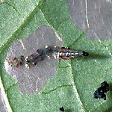 Typical Leafminer
Typical Leafminer 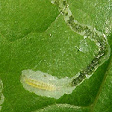
Cigar Case Bearer (Coleophora caryaefoliella) adult is a brown moth with fringed wing margins up to 9mm across. The tiny lava has a black head and feed beneath the epidermal layer of the leaf and over winters in small cigar-shaped cocoon. Commonly found on Carya species.
Cineraria Leaf Miner (Chromatomia syngenesiae) is in the family Agromyzidae. This insect has a complete metamorphosis: egg, larva, pupa and adult. The adult is a small (2mm) black fly. Female adults puncture the undersides of leaves to feed on the sap. Cream coloured larvae (maggots) are miners, up to 5mm long, and their tunnels appear as a tracery of irregular white lines on the leaves, through which the larvae will be visible on the lower surfaces. The pupa is darker-coloured, barrel-shaped and up to 2.5 mm in length.
The feeding of females causes small rust-like spots to appear on the upper surface of leaves. The eggs are deposited on the undersides of the leaves. The tunnels of the larvae become wider as the insect grows and may eventually cause the infested foliage to wilt. Heavily infested plants will die; more often, the appearance of the plant is spoilt by the disfigured leaves, even though it will still produce flowers.
Cypress Moth (Recurvaria apicitripunctella) female adult is a small, yellowish with fringed wings and black markings. The larva tunnels into leaves and then ties them together with silken web, it found on Taxodium mucronatum.
Grevillea Leaf Miner (Peraglyphis atimina) a tiny larvae that eats the inner tissue of leaves and forms tunnels that expand as they grow.
The Leaf Miner (Epinotia nanana) is an olive green caterpillar with a brown head that attacks the base of the leaf and webs them together as it progresses. It is found in Tsuga species.
The Leaf Miner (Lithocolletis crataegella) lava forms tunnels in the inner tissue of the leaf, which becomes wider forming blisters that turn light brown. It normally occurs during late spring attacking unfolded leaves of many plant species including Crataegus.
Macadamia Leaf Miner (Arocercops chionosema) larva forms tunnels that lead to blisters in the leaves and the adult moth is brown with silver bands.
Damage Caused
There is a range of symptoms as a result of attack. Damage appears initially as tunnels on the underside of the leaves, which become broader. The leaf may form blisters and turn a rusty colour with patches visible on both sides. Continual feeding can cause the leaf to fall prematurely and give the plant an unattractive appearance. This attack is a serious problem in a forestry situation but is normally insignificant in a domestic garden. Attacks may be sporadic.

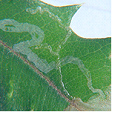 Banksia integrifolia
Banksia integrifolia
Cineraria Leaf Miner
Tunnels begin to appear in early spring and continue through early summer, particularly during cooler, humid periods. The adult fly is inconspicuous and tends to go unnoticed - its presence is indicated by the appearance of the rust-like spots on the leaves as described above. Tunnels of larvae, in which the maggot pupates, may become up to 2mm wide and cover most of the surface of the foliage.
Period of Activity
The larvae are active from summer to autumn and are found from the tropics to temperate regions and generally the eggs are laid on the underside of leaves.
Susceptible Plants
There is a wide range of ornamentals and native plants that are attacked by leaf miners, including vegetables, perennials, annuals, shrubs and trees such as Nyssa sylvatica.
Aquilegia species leaves are attacked by the leaf miner (Phytomyza minuscula) which causes obvious winding white tunnels across the leaf surface.
Betula species are attacked by the leaf miner (Fenusa pusilla). The small black sawfly emerges from the soil primarily during spring. The small worm-like white lava feeds on the fresh new growth, and may cause substantial damage. Adults that emerge later in the season cause less destruction as the lava ignore mature leaves feeding only on new growth.
Buxus species are attacked by the leaf miner (Monarthropalpus buxi) that causes water soaked areas on the underside of leaves as the lava tunnels beneath the epidermal layer.
Cornus species are susceptible to the leaf miner (Chalepus dorsalis) yellowish lava up to 7mm long that tunnels the leaves causing blisters and the adult beetles skeletonise the underside of the leaves.
Leucanthemum and Dendranthema species are attacked by the Chrysanthemum Leaf Miner (Phytomyza atricornis).
Macadamia species and Stenocarpus salignus are attacked by the Macadamia Leaf Miner.
Pericallis x hybridus (Cineraria) is attacked by the Cineraria Leaf Miner (Chromatomia syngenesiae). Leafy vegetables are also susceptible, as are plants in the Asteracea family and related ornamentals such as chrysanthemums, nasturtiums, and gerberas. Sow thistle and other leafy weeds are hosts for this insect. The foliage becomes covered with unsightly, tortuous silvery lines which ultimately ruin the appearance of the plant. Heavy infestations cause wilting and death of the plants. Do not take cuttings from affected plants.
Verbena species are attacked by the leaf miner (Agromyza artemisiae), which mines the leaf margins.
Cultural Control
It is difficult to control leaf miners and damaged leaves may be removed then destroyed from localised infestations.
Biological Control
Many leaf miners are attacked by parasitic wasps and small birds which reduces numbers.
Chemical Control
Chemical treatment includes spraying with dimethoate; note that it is advisable to treat the plants before the larvae pupate and being certain to cover the new growth avoiding reinfestation.
Note
Always read the label for registration details and direction of use prior to application of any chemicals.
PEST
NAME
Scale Insect
Various Scale Species
ORDER
Hemiptera
Description of the Pest
Generally scales are soft bodied insects that have a hard (armoured) or soft covering to hide under. They have piercing and sucking mouth parts that are attached to the host, feed off sap and soft scales commonly producing sweet honeydew, which in turn attracts sooty mould and ants.
The adult female has a circular or oval covering depending on the species and is up to 8mm across. The first stage (crawlers) hatch and wander around the leaf surface until finding a suitable place to suck sap, normally in colonies and the smaller male is relatively inconspicuous.
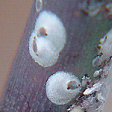 Hard Scale
Hard Scale 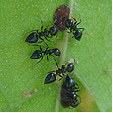 Soft Scale, attending Ants
Soft Scale, attending Ants
Cactus Scale (Diaspis echinocacti) has a circular greyish female and a narrow white male scale and is commonly found on house plants.
Chain Scales (Pulvinaria species) adult females are obvious with large group of eggs that are white or cottony-like, and the tiny young light green scales are flat and oval-shaped up to 2mm long. The legged nymphs are normally arranged from head to tail along the mid rib of the leaf, and may move to a new position to feed. They excrete honeydew and attract sooty mould and are found on Acacia and Acronychia species.
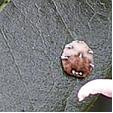 Chinese Wax Scale
Chinese Wax Scale
Chinese Wax Scale (Ceroplastes sinensis) is a domed wax scale that has dark spots around its margin and immature scales form waxy material around there margins.
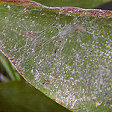 Fern Scale on Aspidistra elatior
Fern Scale on Aspidistra elatior
Fern Scale or Coconut Scale (Pinnaspis aspidistrae) appears as flecks up to 0.15mm long with a white covering over the male congregating on the underside of the fronds on the axils and among the sporangia causing them to turn yellow. Many species of fern are susceptible to infestation.
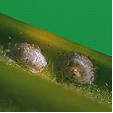
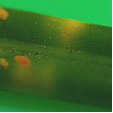 Flat Brown Scale
Flat Brown Scale
Flat Brown Scale (Eucalymnatus tessellates) are light brown up to 0.5mm long, flat and closely attached both sides of the leaf and causing yellowing of the foliage.
Juniper Scale (Diaspis carueli) is tiny and circular, white maturing to grey-black and as it feeds the needles turn yellow and die.
Oleander Scale (Aspidiotus hederae) is a pale yellow circular scale up to 3mm across and is found in dense colonies on the stem or leaves.
Tea-tree Scale (Eriococcus orariensis) are a creamy blue colour normally packed along the branches and are plump and rounded to 4mm across.

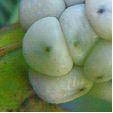 Wattle Tick Scale
Wattle Tick Scale
Tick or Wattle Scale (Cryptes baccatus) adult is domed, blue-slate colour with a leathery covering up to 10mm long. All stages of growth are found in groups of over forty, packed along the stems and normally tended by ants as they produce large amounts of honeydew. A serious pest of Acacia species found inland or coastal from temperate to sub tropical climates and commonly accompanied by Sooty Mould.
Toxic Scale (Hemiberlesia lataniae) is a tiny flat rounded scale up to 0.15mm long and is white to pale pink. It is normally found in colonies on the small branches and twigs of shrubs. It injects a toxic substance into the host as it sucks sap causing the death of the branch.
Wattle Scale (Pseudococcus albizziae) is soft, plump and secrets cotton-like threads. It is not a true scale insect and is simular to mealy bugs. It is reddish-brown up to 0.4mm long and secrets large amounts of honeydew as it sucks sap in colonies along the branches.
Life Cycle
These insects have a Hemimetabolous life cycle, ie. When the immature nymphs resemble the adults.
Appearance of the Pest
All parts of the plant above the soil may be attacked, but normally the stems and leaves and scale tends to favour well-lit positions.
Period of Activity
The nymphs and females are active for most of the year, in warm climates. Once they selected a position they attach and don't move. Normally the winged or wingless males are mobile and only soft scales produce honeydew.
Susceptible Plants
There is a wide range of susceptible plants including citrus, willows, holly, and many ornamentals, such as roses or Paeonia species. It also attacks indoor or glasshouse plants and Australian native plants such as wattles, hakeas, grevilleas and eucalyptus.
Acacia species are attacked by the Tick or Wattle Scale, which infest twigs and small branches and heavy infestations will kill the host plant.
Acer species are attacked by the Cotton Maple Scale (Pulvinaria innumerabilia) which prefers Acer saccharinum. Nymphs first attack the leaves and the brown adult scale is covered in a woolly mass up to 14mm across, normally found on the underside of the stems and twigs.
Acmena smithii, Melaleuca, Syzygium and Pittosporum species are attacked by the Chinese Wax Scale.
Aesculus species are attacked by several scale insects including the Walnut Scale (Aspidiotus juglans-regiae) which is saucer-shaped and attacks the main trunks.
Agave species are susceptible to several types of scale including (Aspidiotus nerii), (Aonidiella aurantii) and (Pinnaspis strachani), but generally do not require control.
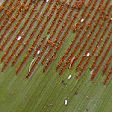 Asplenium australasicum
Asplenium australasicum
Asplenium australasicum is susceptible to Coconut Scale or Fern Scale (Pinnaspis aspidistrae). It is normally found on the under side of the fronds. Small infestations cause little damage.
Bougainvillea species may be attacked by the soft scale (Coccus hesperidum) outdoors or under glass.
Calluna and Vaccinium species are attacked by the Oyster Shell Scale (Lepidosaphes ulmi).
Camellia species may be attacked by the Florida Red Scale (Chrysomphalus aonidum), which is small, circular and black and is found firmly attached to the underside of the leaf along the veins. On inspection after removing the scale the insect has a pale yellow body. Camellias are also attacked by a large variety of scale insects including Tea Scale and Camellia Scale.
Carpinus species may be attacked by the scale (Phenacoccus acericola). It is found on the underside of the leaves forming a white cotton-like clump along the veins.
Casuarina and Allocasuarina species may be attacked by the Casuarina Scale (Frenchia casuarinae), a black hard scale that is upright to 4mm with a pinkish body. During attachment the surrounding tissue swells up and in time can, form galls. This weakens the wood and in severe infestations may kill the tree.
Cotoneaster species are attacked by up to four species of scale including the Oyster Shell Scale (Lepidosaphes ulmi).
Cupressus species are attacked by Bark Scale (Ehrhornia cupressi) is pink and covered in white wax. Heavy infestations cause the leaves to turn yellow or reddish.
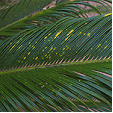 Flat Brown Scale on Cycas revoluta
Flat Brown Scale on Cycas revoluta
Cycads, palms and some species of Callistemon are attacked by the Flat Brown Scale.
Erica species are attacked by several species of scale including, Greedy, Oleander and Oystershell scale.
Jasminum species can be infested with up to twelve types of scale.
Juniperus x media and other conifer species are attacked by the Juniper Scale.
Leptospermum species are attacked by the Tea-tree Scale which produces ample honey dew that promotes sooty mould.
Palm and Fern species are susceptible to attack by the Coconut Scale or Fern Scale (Pinnaspis aspidistrae) which infests the underside of the leaves. They are also hosts for many other scale species such as red, cottony cushion and tea scale.
Pinus species are attacked by several species of scale including the Pine Tortoise Scale (Toumeyella numismaticum) and the Red Pine Scale (Matsucoccus resinosae).
Polygonum odoratum is attacked by a small brown scale.

Sorbus aucuparia is attacked by a five species of scale insect, including Black Cottony Maple, San Jose and Scurfy. Generally they suck on the sap of the new growth and leaves.
Strelitzia species are attacked by the Greedy Scale (Aspidiotus camelliae).
Damage Caused
Leaves become yellow and are shed prematurely and there may be twig or stem die-back. When the infestation occurs on fruit, the fruit is small and its skin becomes pitted and cracked. Small trees and saplings that are heavily infested may be seriously damaged or die. Sooty mould can cover fruit or leaves causing a secondary problem.
Cactus Scale can completely cover the host cactus sucking sap and causing it to die.
Cultural Control
Dead or damaged parts of the plant should be removed and destroyed including fallen fruit. Small infestations may be removed by hand or squashed on the stems. Healthy plants are less susceptible to attack, so maintain vigour of the plant and avoid using high-nitrogen fertiliser that produces excessive soft young growth.
When pruning susceptible plants paint the cuts with antifungal sealant paint as scale insects are attracted to the sweet smell of the sap. This will reduce the infection rate of the plant.
Biological Control
Natural predators such as parasitic wasps may reduce numbers of active nymphs; parasitic wasps are bred commercially in some areas for this purpose. It should be noted, however, that wasps would avoid dusty conditions.
Other predators that assist in control are assassin bugs, ladybirds, lacewings, hover flies and scale eating caterpillars. A variety of birds also attack scales.
The control of ants that transport aphid from one host to another also reduces infestation and can be carried out by applying at least three greased bandages 5mm apart around the stem or trunk of the plant.
Chemical Control
Spray the entire plant with dilute white oil solution; a follow-up spray may be required after four weeks, for heavy infestations. Spraying of chemicals will also kill of natural predators and in some cases the secondary scale infestation is more prolific especially when using copper based chemicals.
Some chemical controls, such as methidathion, are available - please seek advice from your local nursery as to the suitable product for your area.
Note
Always read the label for registration details and direction of use prior to application of any chemicals.
PEST
NAME
Thrips (General)
Various Thrip Species
ORDER
Thysanoptera
Description of the Pest
There are many species of thrips that attack living and dead plant material. The winged adults are black, yellow, white or brown with slender bodies and up to 2mm long. The folded fringed wings appear as silvery stripes and the smaller nymphs are difficult to see, but are wingless simular to the adults. Both adults and the first two nymphal stages have rasping and sucking mouthparts.
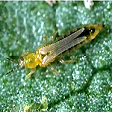 Thrip species
Thrip species
Boree Gall (Kladothrips species) adults are gall producing thrips that form smooth bubble-like or irregular spiny growths on the leaves. These galls can contain up to 1000 insects that also reproduce inside, and are trapped until the gall dries or splits open. Commonly found in inland areas attacking the phyllodes of Acacia species.
Glasshouse Thrips (Heliothrips haemorrhoidalis) is a slender up to 15mm long with small fringed wings. The adult lays eggs on the underside of leaves where the nymphs emerge as miniature adults but wingless. Then feed on the soft leaves leaving a silvery mottled appearance.
Appearance and Distribution of the Pest
Thrips are found from tropical to temperate regions preferring a cool mild winter followed by a dry sunny spring that produces abundant flowers and new foliage. It is dispersed by flying and can be carries great distances on the wind.
Life Cycle
These insects have a Hemimetabolous life cycle, ie. When the immature nymphs resemble the adults.
The female adult lays her eggs using an oviposit in a slit on flower stems or occasionally leaves. The eggs develop into four nymphal stages. The first two stages occur on the plant and the last two in the surrounding soil or in leaf litter, emerging as adults and flying to reinfect the plant. It takes ten to thirty days to develop from egg to adult depending on the temperature and rainfall. Under opium conditions thrips are produced in plague proportions.
Period of Activity
Thrips are most active during warm dry, calm weather, but dislike the soil to be too dry or wet.
Damage Caused
Thrips congregate inside the flowers damaging the epidermal layer, allowing sap to leak out. This causes the flower petals to become brownish and curl along the margins. They also attack the upper surface of leaves causing a silvery discolouration as they suck the sap. The effect is a reduction in fruit and seed production on the host plant.
Susceptible Plants
Generally many plants species are attacked by thrips including buds, petals and leaves that are soft are at most risk, such as Alyogyne , Baeckea, Hibbertia, Hibiscus and Leptospermum species. There is also a wide range of ornamentals suseptable to attack including apples, pears, citrus, stonefruit, grapes and strawberries.
Buddleja species may be attacked by the thrip (Hercinothrips femoralis).
Cordyline, Agave, Dracaena and Howea species, Ficus elastica are attacked by the Dracaena Thrips (Parthenothrips dracaenae) which feed of the leaves.
Knightia excelsa is attacked by thrips by feeding on the chlorophyll in the leaf causing significant paling of the leaves. Stresses plants are more susceptible and plants rarely die from attack.
Peperomia, Cissus, Tropaeolum and Passiflora species and some fern species are attacked by Glasshouse Thrips which can cause heavy damage in inclosed areas such as a glasshouse.
Watsonia species are attacked by the Gladiolus Thrips (Taeniothrips simplex).
Cultural Control
There is no satisfactory cultural control. Small infestations may be ignored or the plant may be hosed to reduce the numbers. Removal of surrounding leaf litter, weeds and cultivating the soil can also reduce the numbers and disturb the life cycle. Care should be taken not to remove flowering weeds under trees that are in bloom as the thrips may migrate on to the tree, alternatively flowering annuals can be planted under trees to attract the thrips away.
Biological Control
No effective natural control though birds; wasp and other predators eat thrips. Weather conditions such as heavy rain help reduces numbers.
Chemical Control
Thrips can be sprayed with Dimethoate or Maldison at least twice every ten days to kill newly hatched nymphs, but may have a detrimental effect on other insects such as bees.
Note
Always read the label for registration details and direction of use prior to application of any chemicals.
PEST
NAME
Diamond Beetle, Diamond Weevil
Chrysolopus spectabilis
ORDER
Coleoptera
FAMILY
Circulionidae
Description of the Pest
The adult weevil is black with blue green patches dotted on its back and is up to 25mm long. The white fleshy larva is legless up to 20mm long and both adult and larva have chewing mouth parts.
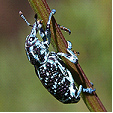
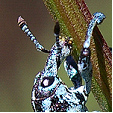
Appearance and Distribution of the Pest
There is a loss of colour in the foliage and stems die back. It is widely distributed throughout eastern Australia.
Period of Activity
These insects have a Holometabolous life cycle, ie. When metamorphosis is observed during the pupal stage.
The alarvae is active during summer followed by the adult .
Damage Caused
The adult chew on the leaves of the host plant and cause little damage and the larvae forms tunnels in the base of the tree or in to the roots.

Susceptible Plants
Stressed or older plants are more susceptible to attack and the normal host plants are Wattles (Acacia species).
Cultural Control
Stressed trees can have there culture improved, but once the symptoms are seen, such as the death of the main trunk replacement of the plant is the main course of action.
Biological Control
There is no effective natural control.
Chemical Control
It is not possible to control with tree injection as the larvae bore into the woody parts of the plant
PEST
NAME
Borer (General)
Various Borer Species
ORDER
Various
FAMILY
Various
Description of the Pest
Generally the larvae bore holes into the heartwood, sapwood or down the centre of twigs though not all borers attack trees. These tunnels may be small or large, deep or shallow and when they emerge from their tunnels at night, they feed on the surrounding tissue. Entrance holes may be covered by a layer of chewed wood fragments ("frass"), silk webbing or exposed and the tunnels may be solitary or form galleries. Certain species attack only twigs and young shoots, while others attack the trunk or roots.
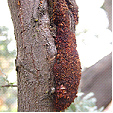 Fruit tree moth borer damage
Fruit tree moth borer damage
The adults female of a fruit tree moth borer normally deposits eggs in damaged areas of the bark or where there is and existing active site. The larvae vary but generally they are creamy to brown, thick soft grub-like reddish brown, and up to 40mm in length.
The adults are white, satiny moths with 40-60mm wingspans with their black abdomens fringed with orange-brown hair or beetle lava that has been deposited in the bark or twigs then tunnels the host.
American Plum Borer (Euzophera semifuneralis) lava is pinkish white to brownish green and attacks the inner bark and cambium region of the tree causing premature death. It is normally found on Platanus orFraxinus species and may also infest many species of fruit trees.
Apple Root Borer (Leptopius squalidus) female adult is a weevil to 20mm long and feeds on the leaves and the plump, legless grub-like lava feeds on the roots of the same host forming tunnels in the deep roots. It is commonly found on Acacia and Eucalyptus species damaging the anchorage of the plant.
Banksia Borer (Cyria imperialis) adult is a black beetle with yellow markings on its wing covers growing to 15mm long. The thickish legless lava is white, tapering from the head and forms flattened tunnels into the heartwood of the host.
Bronze Birch Borer (Agrilus anxius) is a bronze coloured beetle up to 14mm long and lays eggs in crevices in the bark. The legless white larva grows to 20mm long and feeds on the sapwood girdling the branch with flat irregular galleries.
Cedar Tree Borer (Semanotus ligneus) is a black beetle with orange and red markings on its wing covers and grows to 12mm long. The larva feeds on the sapwood of Sequoia, Thuja species and Pinus radiata with curved tunnels that may girdle branches.
Chestnut Borer (Agrilus bilineatus) adult is a tiny slender, blackish green beetle up to 8mm long emerging during spring. The small white larvae have a flat head and are up to 15mm long, forming galleries under the bark of Quercus species.
Cypress Bark Beetle (Phloeosinus cupressi) adult is dark brown with a blackish head, oblong in shape up to 3mm long. The tiny beetles tunnels under the bark of the host and deposits eggs. After hatching the tiny 4mm long, legless larvae bore into the heartwood damaging the tree. After they pupate in the tunnel they emerge through small round holes, commonly many together on the trunk. Damaged trees show signs of browning and dead leaves in the upper branches or falling damage twigs. Cupressus species are particularly vulnerable to attack.
Deodar Weevil (Pissodes nemorensis) is brownish with an obvious snout feeding on the cambium layer and deposits eggs in the bark of the leader and branches. The white lava tunnel the wood eventually killing the leader.
European Corn Borer (Pyrausta nubilalis) is a small moth that lays up to twenty eggs on flower buds. The young flesh coloured larvae mature to a reddish brown and each of its segment has four, spined dark spots.
Elephant Weevil (Orthorhinus cylindrirostris) is a grey or black insect up to 20mm long and lays eggs in the bark near the base of stressed trees. The larva tunnels its way through roots or trunks depositing frass as it goes, then emerging from a second round hole. The adults eat strips from the leaves, normally not bothering the plant.
Elm Borer (Saperda tridentate) adult is a greyish beetle with red bands and black spots on its wing covers and is up to 12mm long. The eggs are laid on the bark and the whitish lava tunnels into the bark and sapwood where it overwinters. It is normally found on Ulmus species.
Iris Borer (Macronoctua onusta) is born from a grey moth with a wing span up to 30mm across, and lays eggs that overwinter in old leaves and debris. As the leaves emerge the eggs hatch entering the leaves at the base, visually forming tunnels and growing to 30mm long. In the later season flower buds may be attacked. Both flowers and leaves eventually turn brown and die.
Lilac Borer (Podosesia syringae) adult is a wasp-like moth that produces pure white lava with a brown head that are up to 25mm long. It initially feeds in the sapwood causing wilting before tunnelling the hardwood making the branches brittle. Evidence of frass is found at the tunnel entrance and secondary fungal attacks infect the holes. Normally found on Syringa species.
Locust Borer (megacyllene robiniae) adult is a black beetle with golden spots, up to 20mm long and produces a small larva that tunnels galleries into the sapwood causing a blackish discolouration. Robinia species are normally attacked.
Mottled Borer (Cryptorhynchus lapathi) attacks Salix species. The adult beetle is black up to 10mm long and the lava bore into the surface of the stem causing swollen growth. Salix species are attacked.
Murry Pine Borer can be two species (Diaoxus erythrurus) and (Diaoxus scalaris). The adults are glossy green-brown beetles that are up to 20mm long and the white grub-like lava is legless, tapering from the head. They tunnel into the sap or hardwood of the trees forming connecting galleries causing ringbarking and creating brittle branches, commonly fond on Callitris species.
Peach Borer (Sanninoidea exitiosa) is a larva that tunnels roots causing gummosis that is mixed with frass at the crown just below soil level. The affected Prunus species produce yellowish leaves and grows poorly. There is another borer, Lesser Peach Borer (Synanthedon pictipes) which attacks any part of the plant from the trunk to the branches and is found on several Prunus species.
Puriri Moth (Aenetus Virescens) a New Zealand short lived moth that grows with a wing span of over 100mm (4in) wide laying eggs on the forest floor at night during spring. The caterpillars grow to 100mm long feeding on leaves and then ascending into the trees and entering the cambium layer up to 150mm deep forming a characteristic '7'-shape burrow that is concealed by frass. The caterpillar may live for 7-years before pupating and collectively they ring bark branches or trunks causing dieback.
Many New Zealand plants including Nothofagus solandri, Pomaderris spp.and ornamentals such as Quercus spp. Betula pendula, Salix spp. Populus spp. Acer spp. Citrus limon and Paulownia spp. are attacked. Control is difficult and generally the plants tolerate attack.
White Pine Weevil (Pissodes strobi) lava feed on the inner bark and sap wood of terminal shoots causing ringbarking and death of the shoot. The reddish brown beetle up to 6mm long is mottled in white and emerges during early summer then lays yellowish lava that are up to 9mm long.
Scribble Moth (Ogmorgraptis scribula) is a grey moth up to 0.4mm wide and produces a cream to brown larvae that is also about 0.4mm long and tunnels in the bark causing a scribble effect. This normally has no detrimental effect on the tree.
Spotted Hemlock Borer (Melanophila fulvoguttata) adult is a colourful metallic beetle with yellowish red spots on the wing covers and lays eggs in cracks in the bark. The white lava is up to 14mm long and forms galleries in the bark and sapwood of the host.
The large Swift Moth and Wood Moths can have a wing span up to 250mm wide and produce large larva that are grub like up to 150mm long, some with horny plates on the thorax. These larvae bore tunnels that are up to 30mm across straight through the heartwood of the host plant. The larvae may live in the tunnel for up to five years before pupating.
Red Cedar Bark Beetle (Phloesinus dentatus) is a small beetle up to 3mm long and lays its larva in excavations in the bark. When the larva emerges they bore galleries in the bark and tend to be more prevalent in stressed or recently transplanted plants.
Vegetable Weevil (Listroderes difficilis) is found during cooler weather (spring or autumn). The adult brown beetle up to 19mm long with a "V" mark on its back and the eggs are laid in the soil around the base of the host plant. The cream coloured lava emerges in spring after rain and feed on the lower leaves forming irregular holes or chewing holes in stems. The lava also feed on fleshy roots boring holes into carrots. Both the adults and lava cause damage, feeding on the plant during the night and resting at the base or under ground during the day. The lava pupates in the soil over winter.
Wattle Web-covering Borer (Cryptophasa rubescens) adult is a satin coloured moth that is up to 50mm across and deposits green fleshy lava that is up to 35mm long. The lava forms shallow tunnels in the bark and sap wood of the host and camouflages it with chewed wood and faeces that is webbed together. Commonly seen attacking the branches on Acacia species.
Life Cycle
These insects have normally have a Holometabolous life cycle. But some borers such as Termites have a Hemimetabolous life cycle.
Eggs are laid singly or in groups, in damaged areas of the bark and branch. Larvae shelter in tunnels they create in the wood and some species may take many years to pupate and emerge as an adult. This may take place in live or dead wood. Other species such as Corn Borer can have up to two generations per year.
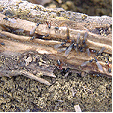 Termites and their damage
Termites and their damage
Distribution of the Pest
Borers are found throughout the world with many species found in Australia both on the coast and inland.
Period of Activity
Varies with the insect concern. Many larvae can be active for many months. Termites are active all year.
Damage Caused
Most damage appears on branches or trunks where the larvae feed on the soft tissue and extensive feeding may cause ring-barking. Normally plants survive borer attack but repetitive attack will cause the death. Certain species are a serious pest in plantations or monocultures such as the Pine Bark Weevil, and the Sirex wood wasp.
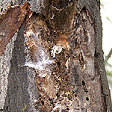 Typical borer damage by a moth larva
Typical borer damage by a moth larva
Chestnut Borer feeds on the sap wood ringbarking large branches and overwinters in the tunnels.
Corn Borer feeds on flower buds and leaves resulting in there death, after which the larva tunnel down the stem causing wilting. There are many crop plants and ornamentals that are affected by this larva.
Swift Moth and Wood Moths weaken trees by boring large tunnels through the branches that may not be noticed until holes are cut through the bark during emergence.
Iris Borer damages leaves to turn brown and wilt, flowers also turn brown and with the aid of a bacterial rot, collapse and die. This damage may be extended to the flower stalk.
Stem Borer (Papaipema nebris) is a small lava to 12mm long, and attacks many garden plants including Lilium, Aster, Alcea and Phlox species
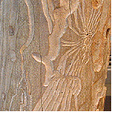 Borer Damage
Borer Damage  Resin oozing from a trunk
Resin oozing from a trunk
Susceptible Plants
There are many plants that are attacked by these pests including Banksia, Callistemon, Melaleuca, Lagerstroemia, Jacaranda species, and flowering stonefruit. Eucalyptus, Acacia species and many ornamental such as Acer species. Plants that are stressed, are particularly venerable.
Acacia and Eucalyptus species are attacked by Swift Moths and Wood Moths.
Acacia species are susceptible to attack from the Wattle Web-covering Borer (Cryptophasa rubescens), which weakens and causes die back of branches.
Acer platanoides is attacked by the Leaf Stalk Borer (Nepticula albostriella) that tunnels into the petiole of the leaf turning it blackish and also attacks the fruit.
Acer saccharinum is attacked by the Petiole Borer (Caulocampus acericaulis) which tunnels in the petioles. It generally attacks the leaves on the lower branches causing them to fall.
Acer species may also be attacked by several borers including the Flat Headed Borer (Chrysobothris femorata), a 25mm long lava of a coppered coloured beetle, that tunnels galleries under the bark girdling the trees The Sugar Maple Borer (Glycobius speciosus) which girdles branches killing them and the Leopard Moth (Zeuzera pyrina) lava that tunnels large holes into branches making them structurally weak. This lava can grow to 80mm long and 12mm thick overwintering in the tunnels.
Banksia species are attacked by the Banksia Web-covering Borer (Xylorycta strigata) a greenish lava up to 40mm long that tunnels down the centre of branch tips. The entrance is covered in silken web littered with faecal material and causes the death of the branchlets.
Betula and Populus species are attacked with the Bronze Birch Borer (Agrilus anxius) and heavy infestation may kill the tree. Populus species are also attacked by the Poplar Borer (Saperda calcarate).
Brachychiton species are attacked by the Kurrajong Weevil (Axionicus insignis) the lava of this plump greyish weevil is white and legless, entering the plant through wounds forming rounded tunnels that may girdle the tree, killing it.
Carya species are attacked by the Painted Hickory Borer (Megacyllene caryae). The adult dark brown beetle has obvious zig zag lines on its wing covers and the lava is cream coloured, both up to 20mm long. The lava tunnels the sapwood of living trees causing ring barking and also tunnels dead trees.
Cornus species are attacked by several borers such as the Flat Headed Borer (Chrysobothris femorata) and the Dogwood Borer (Thamnosphecia scitula).
Cupressus species are attacked by the Cypress Bark Beetle (Phloeosinus cupressi) causing the branches to turn brown and die off from the top or causing the leaves to wilt. On first indication of infestation selective prune off damaged areas or remove the tree.
Hakea sericea and other Hakea species are attacked by the Web-covering Borer (Neodrepta luteotactella). The larvae bore into the twigs and fruit forming a small covering of frass. This insect also infects Macadamia species. Hakeas are also attacked by several other web-covering borers.
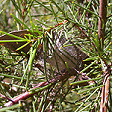 Hakea sericea
Hakea sericea
Pinus and Picea species are attacked by the White Pine Weevil (Pissodes strobi) in the northern hemisphere.
Samanea saman is attacked by the borer (Xystrocera globosa) which chews into the sap wood of stressed trees and can cause serious damage.
Sorbus aucuparia is attacked by the Round Headed Borer (Saperda candida) which forms galleries in the trunk at ground level, forming round holes in the bark.
Tilia species are attacked by the European Bark Borer (Chrysoclista linneela), which feeds on the bark and thew Linden Borer (Saperda vestita) that attacks the base of the trunk or roots.
Tsuga species are attacked by Spotted Hemlock Borer (Melanophila fulvoguttata).
Vaccinium ovatum is infested by the Azalea Stem Borer (Oberea myops). The yellowish lava of this beetle bores into the tips of stems during the flowering period and is up to 12mm (½in) long. It is also commonly found on Rhododenron species.
Control
Cultural Control
Larvae may be destroyed after exposure by pulling away the covering pad of frass, or by pushing a length of wire into the tunnel. Damaged branches may be removed. Improve the culture by feeding and watering the plant.
 Frass due to the Fruit tree moth borer
Frass due to the Fruit tree moth borer
Biological Control
No effective biological control though certain species of trees exude gum or resin sealing the holes and limiting the activity of the larvae or causing its death.
Chemical Control
There is no satisfactory chemical control most borers of live wood.
Note
It is your responsibility by law to read & follow the directions on the label of any pesticide
DISEASE
NAME
Anthracnose (General)
Various Anthracnose Species
Description
This fungus is a casual organism that attacks leaves, flower, fruit, seed and twigs of the host.
Symptoms
Circular black spots appear primarily on the leaves or fruit but may also occur on the stems and flowers. The spots have a definite margin that may turn purple or black with age. As the spot enlarges the centre dries and may fall out giving the leaf a shot hole appearance or become sunken in some fruit while others form soft blackened areas. Infected leaves turn yellow then fall prematurely and fruit that is infected generally becomes black and rotten as it matures.
There are many variations in the symptoms depending on the type of plant and the species of fungus but generally as the fungal spots merge they form brownish to black dead areas.
Plane Anthracnose (Gnomonia platani) first appears on young leaves and as the leaves mature light brown spots appear along the veins and eventually engulf the entire leaf causing death. The twigs are also infected and often fall to the ground when dead and branches die after cankers appear lower down. This is a serious problem for Platanus occidentalis in North America.
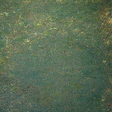 Anthracnose in turf
Anthracnose in turf
The Anthracnose (Colletotrichum species) and (Microdochium bolleyi) infects winter Turf Grasses. At first yellow patches appears which turn red brown then the leaf blades turn whitish and die. This forms bare areas and (Colletotrichum species) forms spine-like fruiting bodies that are tiny and can only be seen using a hand lens.
Wither Tip (Colletotrichum gloeosporioides) forms spots on the leaves and flowers and the stems form cankers that cause wilting at the top of the branches. Commonly found on Aucuba species.
Source and Dispersal
The fungal spores are dispersed by wind from infected plants or parts of plants. It is also dispersed by splashing water or contaminated stock.
Favoured Conditions
The fungus prefers cool humid climates and is not commonly seen in warm coastal regions and may continue living in dead wood, leaf litter or harvested fruit.
Affected Plants
The Anthracnose species is found shrubs, vegetables, trees particularly fruit trees such as mango or macadamia and large trees such as Platanus species.

 Acer negundo
Acer negundo
Acer species are infected by the Anthracnose (Gloeosporium aporcryptum). Irregular shaped light brown spots appear on the leaf, joining to form large dead brown areas and giving the leaf a scorched appearance. Leaves may be fully or partially damaged, often causing the leaf to die prematurely. During constant wet weather this can become a serious problem. Acer saccharinum (Silver Maple) and Acer negundo (Box Elder) are particular susceptible and small plants may be sprayed with a fungicide as the new foliage appears to help control infection
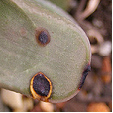
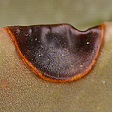 Agave species
Agave species
Agave species are susceptible to Glomerella Leaf Blight (Glomerella cingulate). This causes dark coloured depressed spots to appear on the leaves. The leaf apex dies and the spreading rot in Orchid species can infect the pseudobulbs causing the death of the plant.
Orchids such as Cattleya, Cymbidium, Cypripedium, Dendrobium, Epidendrum, Oncidium, Paphiopedilum, Phalaenopsis and Zygopetalum species are infected by Glomerella Leaf Blight (Glomerella cingulate).
Agrostis palustris (Bent Grass) is particularly susceptible to Anthracnose (Colletotrichum species) and (Microdochium bolleyi), but this fungal problem is also found on Cynodon dactylon (Couch), Lolium perenne (Ryegrass) and Festuca arundinacea (Tall Fescue). These grasses are infected in areas of poor drainage or where leaf wetness is prolonged. Low soil fertility may also contribute to infection and it is commonly found in coastal regions.
Anthurium species are susceptible to the Anthracnose (Gloeosporium minutum) which causes circular spots on the leaves, along the margins. These meld together forming dead brown areas that dry and fall out. It is commonly found in a glasshouse situation. The spadix is also infected by Spadix Blight (Colletotrichum gloeosporioides) which forms dark spots that enlarge, spoiling the flower.
Antirrhinum species are susceptible to the Anthracnose (Colletotrichum antirrhina) which attacks stems and leaves forming sunken oblong spots that are yellowish with a brown margin.
Cactus species are susceptible to anthracnose causing shot hole disease, which attacks the pads of Opuntia species (prickly pear). It appears and during the hot humid months of the year and is distinguished by the appearance of small brownish spots that turn grey with black spores under the drying skin. Control methods include removal of infected pads and treating wounds with disinfectant.
Digitalis species are infected by the Anthracnose (Colletotrichum fuscum). This fungus forms rounded spots that are purplish-brown and may have a purplish border. Fruiting bodies appear in the centre as the spots enlarge.
Leucadendron and Leucospermum species are susceptible to Anthracnose (Colletotrichum gloeosporioides). This causes the new growth to die back, leaf spots appear and cankers to form on the stems. It also causes damping-off of seedlings, which can be a major problem for Protea species as the fungus can be carried in the seeds.
Limonium species are infected by Wither Tip (Colletotrichum gloeosporioides). This is a serious disease causing spots on the leaf, flower and stems or rotting the crown.
Ribes species are attacked by (Pseudopeziza ribis). This infection causes circular brown-black spots on the leaves and premature defoliation of the plant. The spots may also appear on the petioles or stems. Infected areas may be sprayed with wettable sulphur weekly.
Schizanthus species are infected by Anthracnose (Colletotrichum schizanthi) which forms eater soaked areas on the stems and petioles, preferring new growth and maturing with canker-like lesions that girdle the stems.
Tilia species are infected by the anthracnose (Gnomonia tiliae), which forms light brown spots on the leaf venation, towards the tip and can defoliate an entire tree.
Spot Anthracnose (Elsinoe ilicis) infects Ilex cornuta forming black spots that may lead to leaf disorder. Opuntia species are infected by (Gleosporium cactorum) in warmer regions.
Vaccinium ovatum is infected by (Gloeosporium minus) and commonly known as Fleck and appearing on the leaf and stems.
Viola species are infected by (Colletotrichum violae-tricoloris) which produces brown blotches with black margins on the leaves.
Non-chemical Control
Avoid watering plants from above or wetting the foliage especially in the late afternoon. When planting allow space between each plant for good air circulation. Remove affected foliage or wood by pruning and dispose off site.
Turf grasses should have well drained soils, high fertility and avoid excessive watering to reduce possible infection.
Chemical Control
Regular spraying where possible during the periods that are favourable for fungus development. Fungicides include;
Systemic types, Biteranol, carbendazim, triforine
Protectants; chlorothalonil, copper oxychloride, mancozeb, thiram, zineb
Note
Always read the label for registration details and direction of use prior to application of any chemicals.
Average Lowest Temperature : -3º C 27º F
USDA : 9, 10
This USDA (United States Department of Agriculture) hardiness zone chart can be used to indicate a plant’s ability to withstand average minimum temperatures. However, other factors such as soil type, pH, and moisture, drainage, humidity and exposure to sun and wind will also have a direct effect on your plant’s survival. Use this chart only as a guide, always keep the other factors in mind when deciding where, when and what to plant.
A plant's individual USDA zone can be found in the Plant Overview.
Region of origin
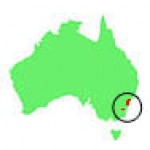
Australia, (Blue Mountains)
Climate Description
Warm Temperate
This zone has the majority of rain during winter in the west and summer in the east with high humidity. Summer temperatures may peak at 40ºC (104ºF).
Frost and drought mainly occur inland and coastal wind is normally accompanied with rain.
Plant growth
Wide range of native and exotic plants grow well.
| Dictionary | Growth Habit |
| Leaf Type | Botanic Flower Description |
| Leaf Shape | Flower Inflorescence |
| Leaf Arrangement | Fruit Type |
| Leaf Margin | Bark Type |
| Leaf Apex And Bases | Flower Description |